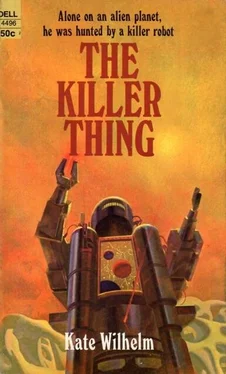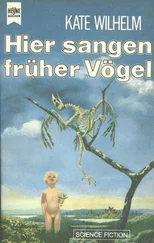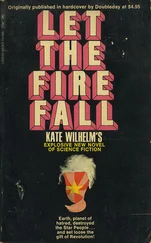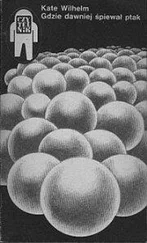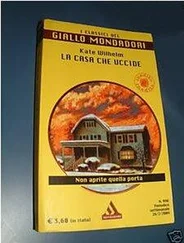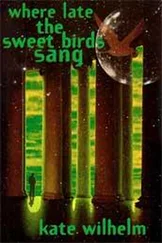The sound of the radiation alarm woke Trace. It was coming! His eyes were bright with fever and his hand trembled when he adjusted the screen to focus in on the target. It was still four miles from him, but coming steadily. His mouth was partially open; he couldn’t close it. He touched his tongue and found it hot and dry, swollen. He was dying. Shaking violently, he started the engines of the dinghy. He would die, but not under the beam of the laser, not from the robot. He eased the dinghy to the mouth of the chimney and stopped it again, without turning off the engine immediately. He would wait until the robot started to enter the valley, and then he would leave it, go as far as his fuel would take him, and die alone. He felt eager to be off, to get started on that, his last retreat.
He watched its progress on his screen, sometimes seeing it singly, sometimes seeing an infinite regression of screens, each with the moving speck of light, stretching out endlessly before him, and he waited. He shook now and again, heaving spasms that left him gasping. “Come on,” he coaxed it. “Come on!” It circled the valley, like a sniffing dog circling a lake to find where its quarry had entered the water. It found the blocked passage and tried it, and was turned back by the sand that filled the narrow cut from wall to wall. It continued its circle. It came to the next passage and hesitated a second. Trace saw the passage through its eyes then: an apparent floor that was fairly level, dotted with rocks and boulders, no different from the rest of the hellish terrain.
It rolled into the passage, its wheels finding traction on the rock base covered with sand. The dot of light moved on the screen. Trace drew in a long, painful breath and held it. The robot moved slowly; having learned that one passage was blocked, it was alert for blockage in this one. Behind it the sand was flattened, small rocks were crushed, glinting new cuts to the sun. Nothing was there to be seen except the trail of crushed rocks and packed sand. The trail grew longer, at a maddeningly slow pace. The sand under its wheels deepened somewhat and it stopped again. It moved forward once more, using the treads now. The sound of rocks being ground to powder was the only sound to be heard. It was as if a shadow passed over the ground, and when it moved on there was new sand where there had been rocks. From both sides of the trail it made, sand trickled in to fill the depressions its treads left. It was unbalanced by the abrupt drop concealed with sand, and for a moment it hung, braking, but under the treads the slithery sand shifted and it was further unbalanced. Behind it where sand trickled into one of the ruts it had left, a rounded rock followed the sand and gravity pulled it, keeping it in the smooth track. It hit the robot from behind, lodging under the tread. Another rock followed, and then another. The robot hung unmoving then; its eight tons against the unsettled sand proved too much, and it slipped four feet before it could make an effort to stop itself. The sudden surge of its weight on the sand pressing against the loosely piled rock wall was more than the wall could bear. It gave way and there was a crash of rocks and sand pouring through the break, as water pours through a broken dam. The robot toppled when the sand shifted from under it. With a thunderous crash, it hit the ground where the grade was steepest. It rolled, and over and around it fell an avalanche of rocks and sand, sweeping up everything in its path. Rocks struck the walls, were dashed back, hit the robot’s screen, and penetrated it. The force shield protected it from high energy impact of any sort, but the rocks were of low energy yield and they hit the robot, as did the sand. In the first ten seconds after its fall the screen controls and the remote control for the dinghy’s screen were inactivated; in the next ten seconds one of the flexible, handlike waldoes was torn loose. It withdrew all other appendages and closed all its apertures, but sand had entered and damage was done.
The robot weighed eight tons. Its crashing fall and roll tore loose boulders from the cliffs themselves. Rocks that the wind had deposited in the passage were loosened and tumbled after the robot. When it stopped rolling it was under a mountain, twenty-five to thirty tons of sand, another thirty-five to fifty tons of rocks and boulders.
Trace stared at the hill of rocks and sand, awed by what he had done. As he watched, the hill stirred, shifted, a rock rolled down from it, then several more, and a spot of brightness appeared near the top. The robot’s laser was still working. It was burning its way out.
It reminded Trace of a nightmare in which no matter how far or how fast he ran, everytime he looked over his shoulder the devil was still there, the same distance, still grinning in anticipation. He watched the red spot until it vanished. The laser had cut through. The robot would widen the opening, dislodging or burning rocks to free itself, and then they would be back where they had started. He watched, but the hole didn’t grow. The robot couldn’t move. The laser happened to be pointing in that direction when it was turned on, but it could not direct the beam to another spot. Trace laughed. His lips cracked more and bled, and it hurt his throat, but he laughed until he was weak and the laughter had turned to sobbing. It passed and he looked again at the hole made by the laser. It had grown slightly. Perhaps it had a range of freedom of an inch or so, back and forth one inch, or two at the most. He took off then in the dinghy as the stabbing laser bit another eighth of an inch away. The top opening grew to almost two inches in length.
Trace landed on the cliff over the passage, and cautiously he eased to the edge to look down on the mountain that was the robot’s burial mound. The cherry glow showed first on one end of the two-inch cut, then on the other. Trace backed away and looked about him. The top of the cliff was covered with stones, rocks from pea size to boulders as big as houses. He grinned and cried out with pain when his lip split further. Water. He could find the dinghy now with the screen turned off, and then he would finish burying the robot.
He almost crashed his dinghy when he landed only twenty feet from the other one, now out in the open and visible. He was crying deep in his throat when his trembling hands opened the emergency stores unit and found the water bags there. Enough water to last him for a month, two months. He drank deeply and in a minute he was sick, vomiting all of it up again. He sipped a mouthful then and let it trickle down. His throat was swollen, almost shut. He was shivering uncontrollably. Much of the water ran down his chin, ran out of his stiff mouth, spilled even before he could get it near his lips. This time the small amount he allowed himself stayed down, and he took another mouthful, and then another.
After he had drunk he loaded the water and the fuel from the robot’s dinghy into his own, and then he returned to the cliff and the robot. He had to stay near it, keep it covered. When the winds started he would return to his chimney and stay there in the shelter. During the night, when the wind was gone, he would light the robot with his spotlights, keep it covered at all times. During the day he would stay on the cliff and it would keep him busy just finding stones he could roll to the edge and push over. He worried about keeping it all done. It was a two-man job, and he was alone. It did not occur to him to leave now, to return to his orbiting ship and wait there for relief. He had trapped it, and he would hold it for them, would direct their fusion bombs to it himself. He looked down at it and saw that the hole was three inches long, first one end of the line turning red, then the other end, as the laser swept back and forth steadily without pause.
Читать дальше
